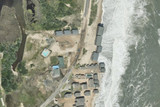September 22,2025
When a natural disaster leaves behind chaos and uncertainty, one aircraft becomes the eyes of the nation: NOAA’s Beechcraft King Air 360.

Image: NOAA
Outfitted with state-of-the-art imaging systems, this twin-engine turboprop is often the very first to fly when conditions clear after hurricanes, tornadoes, floods, or even oil spills. Its mission? To capture a clear, georeferenced view of what’s happened on the ground and in coastal waters — information that is vital to saving lives and speeding recovery.
Built for the Mission
The King Air 360 isn’t just a dependable aircraft; in NOAA’s hands, it’s a flying survey lab. With its ability to fly low, steady, and long, the King Air collects precise aerial imagery across large areas in a matter of hours. Every image is tagged with exact geographic coordinates, so emergency managers can trust what they’re seeing and act on it quickly.
For NOAA, this aircraft provides a perfect balance of reliability, efficiency, and cost-effectiveness. It can operate from smaller regional airports close to the disaster zone, ensuring response time is measured in hours, not days.
Aerial Data That Saves Time — and Lives
The imagery collected aboard the King Air 360 is more than just a snapshot of destruction. It provides essential insights for:
-
Identifying hazards to navigation and potential HAZMAT spills
-
Locating stranded or displaced vessels
-
Supporting search and rescue operations
-
Assessing property and infrastructure damage through before-and-after comparisons
-
Guiding recovery and rebuilding strategies at both local and national levels
Hurricane Erin: A Mission in Action
In the aftermath of Hurricane Erin, NOAA’s King Air 360 was deployed to survey the hardest-hit coastal regions. Working in coordination with federal and state partners, the aircraft focused its advanced imaging systems on priority areas, producing data that could be used immediately by responders on the ground.

Image: NOAA
That data isn’t locked away — NOAA makes its Emergency Response Imagery available to the public online. This transparency ensures everyone, from federal agencies to local communities, can use the information to make informed decisions.
The Quiet Hero of Disaster Response
While recovery headlines often focus on ships, helicopters, and boots on the ground, the King Air 360 is one of NOAA’s quiet heroes. From the air, it delivers clarity when the world below is clouded by destruction. Its dependable design and advanced technology help NOAA fulfill its mission: keeping people safe, protecting the environment, and supporting resilient communities.
✅ You can view the latest NOAA Emergency Response Imagery from Hurricane Erin once it becomes avaiable by visting www.oceanservice.noaa.gov

